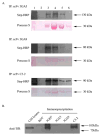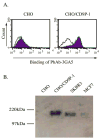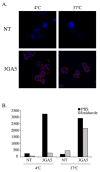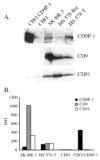Identification and characterization of tumor antigens by using antibody phage display and intrabody strategies
- PMID: 17498801
- PMCID: PMC2739904
- DOI: 10.1016/j.molimm.2007.03.023
Identification and characterization of tumor antigens by using antibody phage display and intrabody strategies
Abstract
To generate a panel of antibodies binding human breast cancers, a human single chain Fv phage display library was selected for rapid internalization into the SK-BR-3 breast cancer cell line. Thirteen unique antibodies were identified within the 55 cell binding antibodies studied, all of them showing specific staining of tumor cells compare to normal epithelial cells. Two of the antibodies bound the ErbB2 oncogene while 6 bound the tumor marker transferrin receptor (TfR). By developing a scFv immunoprecipitation method, we were able to use LC-MS/MS to identify the antigen bound by one of the antibodies (3GA5) as FPRP (prostaglandin F2alpha receptor-regulatory protein)/EWI-F/CD9P-1 (CD9 partner 1) an Ig superfamily member that has been described to interact directly with CD9 and CD81 tetraspanins and to be overexpressed in adherent cancer cell lines. Although the 3GA5 scFv had no direct anti-proliferative effect, intracellular expression of the scFv was able to knockdown CD9P-1 expression and could be used to further define the role of the tetraspanin system in proliferation and metastasis. Moreover, the 3GA5 scFv was rapidly internalized into breast tumor cells and could have potential for the targeted delivery of cytotoxic agents to breast cancers. This study is the proof of principle that the direct selection of phage antibody libraries on tumor cells can effectively lead to the identification and functional characterization of relevant tumor markers.
Figures






References
-
- Adams GP, Tai MS, McCartney JE, Marks JD, Stafford WF, 3rd, Houston LL, Huston JS, Weiner LM. Avidity-mediated enhancement of in vivo tumor targeting by single-chain Fv dimers. Clin Cancer Res. 2006;12:1599–605. - PubMed
-
- Akerstrom B, Nilson B, Hoogenboom H, Bjorck L. On the interaction between single chain Fv antibodies and bacterial immunoglobulin-binding proteins. J Immunol Methods. 1994;177:151–63. - PubMed
-
- Bartlett GR. Phosphorus assay in column chromatography. J Biol Chem. 1959;234:466–8. - PubMed
Publication types
MeSH terms
Substances
Grants and funding
LinkOut - more resources
Full Text Sources
Other Literature Sources
Research Materials
Miscellaneous

